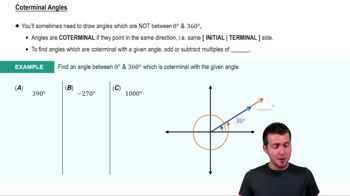Here are the essential concepts you must grasp in order to answer the question correctly.
Angle of Depression
The angle of depression is the angle formed by a horizontal line and the line of sight to an object below that horizontal line. In practical terms, it is measured from the observer's eye level down to the object. Understanding this concept is crucial for solving problems involving heights and distances, particularly in scenarios like the one described, where a floodlight's position relative to the ground is analyzed.
Recommended video:
Trigonometric Ratios
Trigonometric ratios, such as sine, cosine, and tangent, relate the angles of a triangle to the lengths of its sides. In the context of the angle of depression, these ratios can be used to calculate unknown distances or angles based on known measurements. For example, if the height of the floodlight and the distance to the point of interest are known, trigonometric functions can help determine the angle of depression.
Recommended video:
Introduction to Trigonometric Functions
Right Triangle Properties
Right triangle properties are fundamental in trigonometry, as they provide the basis for applying trigonometric ratios. In problems involving angles of depression, the scenario often forms a right triangle where one leg represents the height of the light and the other leg represents the horizontal distance to the point of interest. Recognizing and applying these properties is essential for accurately solving the problem.
Recommended video:
 Verified step by step guidance
Verified step by step guidance Verified Solution
Verified Solution



 4:18m
4:18m